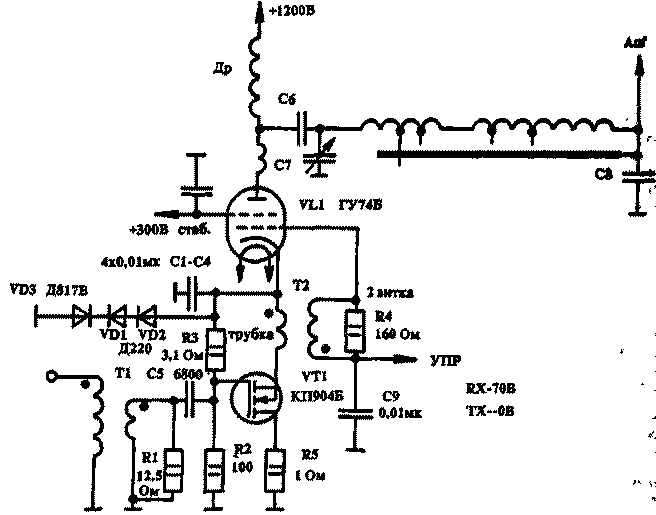
|
|
ENCYCLOPEDIA OF RADIO ELECTRONICS AND ELECTRICAL ENGINEERING Tube power amplifier. Encyclopedia of radio electronics and electrical engineering
Encyclopedia of radio electronics and electrical engineering / RF power amplifiers In recent years, amateur radio transceivers, as a rule, are made low-power - from 3 to 5 watts. In this regard, when designing a power amplifier, the question arises which of the known schemes to apply in order to obtain single-sideband and telegraph signals at the amplifier output with the above parameters that meet all the technical requirements currently imposed on category 1 amateur radio stations. Classic "grounded grid" and "grounded cathode" amplifier circuits are not suitable, since the excitation voltage of a transceiver with an output power of 3-5 W is clearly not enough (for example, at a power of 3,5 W, there is 50 Volts at a 15 Ohm resistance). There is a so-called hybrid power amplifier circuit, which has recently been often used by radio amateurs. But this circuit is a degraded version of the "grounded grid" amplifier. The power received in this circuit from a radio tube, at best, can reach 70% of the guaranteed for this radio tube, since the transistor in the cathode of the tube is a current limiter. Due to poor matching between the radio tube and the transistor, reflected waves occur, which threatens to breakdown the transistor and worsens the signal shape at the output of the amplifier. The slope of the tube characteristic is not fully utilized. The author tried to create an amplifier devoid of the shortcomings of the above circuits. To what extent he succeeded - to judge by radio amateurs. The main parameters of the amplifier on the GU-74B lamp:
The amplifier circuit is shown in the figure. The amplifier uses a KP904B transistor and a GU-74B radio tube (it is possible to use other modern ceramic-metal and metal-glass radio tubes). The scheme works as follows. The excitation voltage through a matching transformer with a resistance ratio of 4:1 (50 -12,5) is applied to the gate of the transistor T1. Standing out in the string load on the transformer Tr2 (1: 4 - 40 -160), the excitation voltage is supplied to the control grid of the lamp. An oscillating system is switched on in the anode of the lamp. The cascade is powered through the DR choke. As can be seen from the figure, to power the transistor with direct current, it is used to turn it into a rolling radio tube. At the same time, the cathode of the radio tube is grounded at high frequency through capacitances C1-C4 (4 pcs. 10H each). To create a current through the lamp - transistor cascade, a positive bias is applied to the transistor from the divider R3 - R2. The quiescent current of the lamp is determined by the ratio of these resistors. It is changed by the value of the resistor R3. Debugging the circuit is reduced to the selection of the quiescent current within 70 ... 80 mA. A small value of the initial current, at first glance, is unacceptable for amplifying a single-sideband signal, but since the circuit has a double OOS both for the cathode and for the grid, the level of all side and non-linear distortions at a given current is negligible. It is necessary to pay attention to the correct switching on of the windings of the transformers TP1 and TP2. TP1 is made on the basis of a copper tube with an outer diameter of 3 mm, bent in the shape of a letter U. Each half is fitted with 4 ferrite rings with an inner diameter of 3 mm, an outer diameter of 9 mm, and a thickness of 10 mm. TP2 is made on the basis of a copper tube with an outer diameter of 5 mm. Each half has 6 M2000 ferrite rings with an inner diameter of 5 mm, an outer diameter of 12 mm, and a thickness of 10 mm. Inside the tubes, 2 turns of wire are threaded from parallel-connected wires of the MGTF-0,15 type. It must be borne in mind that the denser the winding is located inside the copper tube, the broadband transformer. To protect the transistor from random overvoltages on the drain, the chain D1, D2, D3 is included. The design of the amplifier is conventional, the anode circuits are shielded from the grid circuits, the grid circuits are shielded from the input circuits. For all questions related to the construction and adjustment of the amplifier, please contact on the air. Author: E. Shelekasov (UV3AX); Publication: N. Bolshakov, rf.atnn.ru
Artificial leather for touch emulation
15.04.2024 Petgugu Global cat litter
15.04.2024 The attractiveness of caring men
14.04.2024
▪ Crystal that purifies the air of carbon dioxide ▪ Nanomaterial for cleaning air on submarines ▪ A camera with a resolution of 400 thousand pixels has been developed ▪ New Class Drones Dragonfly Pictures ▪ High-speed camera 4,8 million frames per second
▪ section of the site RF power amplifiers. Article selection ▪ Sherlock Holmes article. Popular expression ▪ article Biomass energy. Encyclopedia of radio electronics and electrical engineering ▪ article Just one chance. Focus secret
Home page | Library | Articles | Website map | Site Reviews www.diagram.com.ua |






 Arabic
Arabic Bengali
Bengali Chinese
Chinese English
English French
French German
German Hebrew
Hebrew Hindi
Hindi Italian
Italian Japanese
Japanese Korean
Korean Malay
Malay Polish
Polish Portuguese
Portuguese Spanish
Spanish Turkish
Turkish Ukrainian
Ukrainian Vietnamese
Vietnamese

 Leave your comment on this article:
Leave your comment on this article: